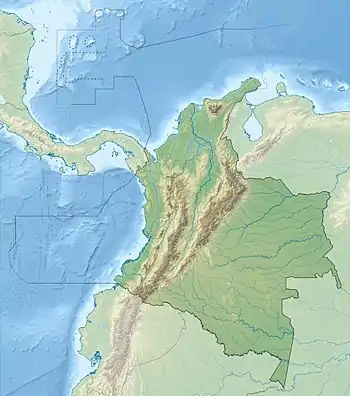| Neotamandua | |
|---|---|
| Scientific classification | |
| Domain: | Eukaryota |
| Kingdom: | Animalia |
| Phylum: | Chordata |
| Class: | Mammalia |
| Order: | Pilosa |
| Family: | Myrmecophagidae |
| Genus: | †Neotamandua Rovereto 1914 |
| Species | |
| |
Neotamandua is an extinct genus of anteaters that lived in the Miocene to Pliocene in South America.
Taxonomy
Their fossils have been found in the Miocene Collón Cura Formation of Argentina,[2] the Honda Group at La Venta in Colombia and the Pliocene Araucano Formation in Argentina.[3] Its closest living relatives are the giant anteater (Myrmecophaga tridactyla) and tamanduas (genus Tamandua).[3][2] The species Neotamandua borealis was suggested to be an ancestor of the giant anteater.[4] Patterson (1992) suggested the Neotamandua fossils are very similar to Myrmecophaga, which would mean Neotamandua may be congeneric with Myrmecophaga.[2]
References
- ↑ Rovereto, Cayetano (1914). "Los estratos Araucanos y sus fósiles". Anales del Museo Nacional de Historia Natural de Buenos Aires. 25: 1–247.
- 1 2 3 "Neotamandua". Paleontology Database. Retrieved 2012-07-23.
- 1 2 Gaudin, T.J. & Branham, D.G. (1998). "The Phylogeny of the Myrmecophagidae (Mammalia, Xenarthra, Vermilingua) and the Relationship of Eurotamandua to Vermilingua" (PDF). Journal of Mammalian Evolution. 5 (3): 248. doi:10.1023/a:1020512529767. S2CID 29173495. Retrieved 2012-07-23.
- ↑ Hirschfeld, S.E. (1976). "A New Fossil Anteater ( Edentata , Mammalia ) from Colombia , S . A . and Evolution of the Vermilingua". Journal of Paleontology. 50 (3). JSTOR 1303522/.
This article is issued from Wikipedia. The text is licensed under Creative Commons - Attribution - Sharealike. Additional terms may apply for the media files.




